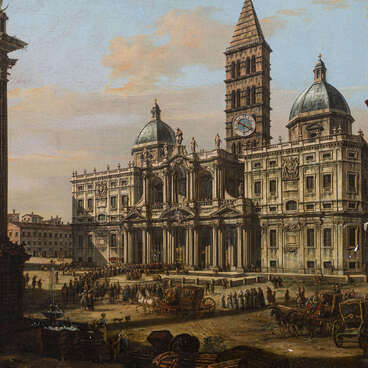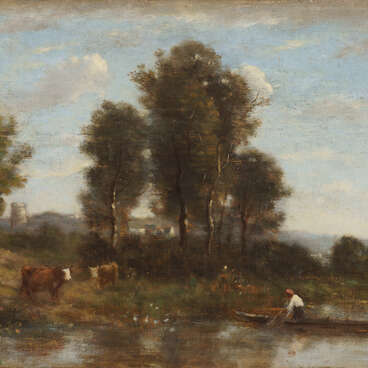Karel Dujardin was a Dutch painter and engraver. The exact date and place of his birth are unknown, but most modern experts assume that he was born in Amsterdam in the 1620s into a family of artists. Dujardin was taught the basics of classical drawing by his father. Later, the young man was apprenticed to the landscape painter Nicolas Berchem, a well-known master at the time, who had the nickname “Theocrit of painting” for his idyllic paintings. Another mentor of the aspiring artist was a brilliant animalist Paulus Potter.
Already an independent painter, Dujardin lived and worked in The Hague, then in Amsterdam and Lyon. Eventually he moved to Italy, where he settled, inspired by the local scenery. The landscapes of Italy made up a large part of his work.
Dujardin’s canvases with nature scenes featured animals as staffage, background figures. However, the artist depicted them so accurately and where they were so “well placed” that the fauna became an important part of his paintings.
The “Landscape with Animals” is among Dujardin’s signature works and shows an Italian panorama with an aqueduct. In the foreground there is a horse standing and a cow and sheep lying down. Painted against a dark brown background, they are illuminated by the rays of the sun, and the horse’s coat is shiny. On the right, almost invisible on the brown ground, there is a dark green clump of grass, one of the attributes of Dujardin’s landscapes. The aqueduct with the people walking along it is the main element of the middle ground. In the background there is a hilly terrain, painted in greenish-yellow tones, and a blue sky with pinkish-gray clouds.
Over time, the artist’s palette changed. At the beginning of his career, Dujardin preferred golden colors, but by the age of forty he began to paint in cool silvery tones.
His legacy is best known for his scenes of rural life, and he often turned to the images of Italian peasants and shepherds. An excellent draughtsman, Dujardin was highly inventive in composing such works and paid the utmost attention to detail.
He also painted portraits and history paintings, as well as genre pictures on religious and mythological subjects. Dujardin was an excellent etching artist. He created more than fifty engravings in which Italian landscapes are recognizable.
Already an independent painter, Dujardin lived and worked in The Hague, then in Amsterdam and Lyon. Eventually he moved to Italy, where he settled, inspired by the local scenery. The landscapes of Italy made up a large part of his work.
Dujardin’s canvases with nature scenes featured animals as staffage, background figures. However, the artist depicted them so accurately and where they were so “well placed” that the fauna became an important part of his paintings.
The “Landscape with Animals” is among Dujardin’s signature works and shows an Italian panorama with an aqueduct. In the foreground there is a horse standing and a cow and sheep lying down. Painted against a dark brown background, they are illuminated by the rays of the sun, and the horse’s coat is shiny. On the right, almost invisible on the brown ground, there is a dark green clump of grass, one of the attributes of Dujardin’s landscapes. The aqueduct with the people walking along it is the main element of the middle ground. In the background there is a hilly terrain, painted in greenish-yellow tones, and a blue sky with pinkish-gray clouds.
Over time, the artist’s palette changed. At the beginning of his career, Dujardin preferred golden colors, but by the age of forty he began to paint in cool silvery tones.
His legacy is best known for his scenes of rural life, and he often turned to the images of Italian peasants and shepherds. An excellent draughtsman, Dujardin was highly inventive in composing such works and paid the utmost attention to detail.
He also painted portraits and history paintings, as well as genre pictures on religious and mythological subjects. Dujardin was an excellent etching artist. He created more than fifty engravings in which Italian landscapes are recognizable.




